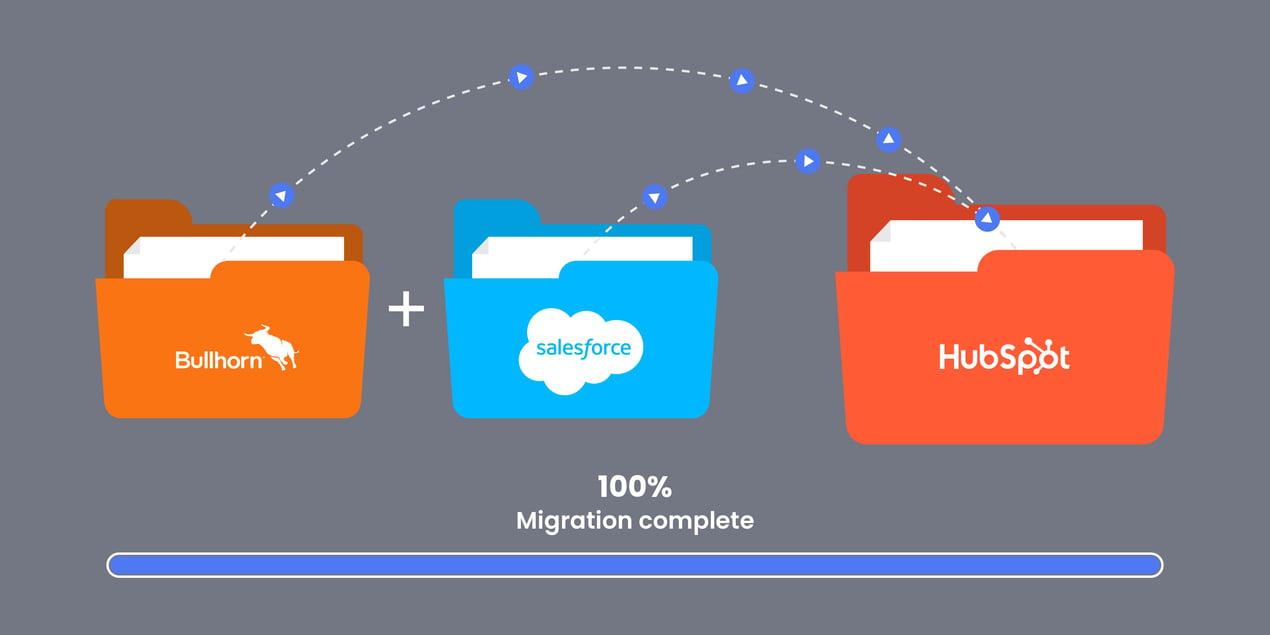Applicant Tracking System - architecture design and data migration to HubSpot CRM
Our client is a specialist recruitment consultancy employing over 100 talent consultants delivering leading talent in information technology, telecommunications, engineering and finance by identifying and developing the best talent in niche market segments.
In order to evolve their business and find efficiencies, both cost and productivity, our customer used Sales Hub Enterprise and two HubSpot custom object limit increases.
The brief
Our client had used Salesforce as its CRM since 2012. The purpose of migrating from Salesforce was twofold. Firstly, the current Salesforce CRM system was outdated and did not evolve with the business. Secondly, the customer did not feel that the licensing costs were comparable to the value being delivered by the CRM.
MO Agency was asked to migrate our client's data and processes from Salesforce to HubSpot CRM and in doing so, demonstrate a reduction in licensing costs and make minor process optimisations.
The challenge
The sheer volume of the multi-object data - 2.3 million records - as well as the intricacy of the customers internal processes made this project complex.
Not only were two custom object limit increases required to accommodate all of the data - 1 million records across 10 custom objects - but in order to import the data into HubSpot by default, the data also had to be cleaned before the migration.
Additionally, due to the existing tech stack, and the way that Salesforce was originally set up, there were several custom objects that needed to be synced to HubSpot.
Separately, all candidate CVs were being manually populated into Salesforce due to poor results from Bullhorn's parsing system being used. This process was very time consuming for their internal admin resources and was not conducive to efficiencies in this part of the business.
Finally, a hard deadline existed for the end of the Bullhorn and Salesforce licensing contract, and in turn the cutover from Salesforce to HubSpot CRM. This needed to be factored into the rollout and implementation planning to ensure that the deadline was met and that sufficient time was factored in to ensure that user testing, optimisation, migrations and delta migrations, and any bug fixes necessary were completed before the usage legacy system expired.
Primary goals
- Migrate Salesforce data to HubSpot CRM.
- Migrate CV data to HubSpot
- Improve on the Bullhorn CV parsing tool.
- Migrate sales process to HubSpot CRM.
- Optimise sales process using HubSpot automation.
- Implement sales reporting
- Opportunity reporting
- Sales activity reporting
- Gross profit reporting
- Demonstrate both process improvements and a net cost reduction using HubSpot.
The solution
The overall duration of the project was ten months, broken up into two phases, namely solution architecture design and set up, and data migration and system enablement.
Phase 1: Solution architecture design and set up
- Properties audit: The existing properties being used by the customer were audited to gain a better understanding of the data points that were required to be migrated over to HubSpot. Based on the audit, the best course of action to utilise HubSpot’s ecosystem and functionally could be determined.
- Custom object build: The Salesforce environment contained more than the default array of objects in Salesforce. Through the property audit, it was determined which objects were required to be kept and which could be combined or removed in HubSpot.
- Properties build: Based on the audit and the finalised list of objects, the properties and the property types that were required were determined. In the set up, permission sets for the properties were also determined, namely which needed to be hidden or otherwise only editable by certain users with specific access.

- CV parser set up and CV editor: A custom third party integration was required in order to parse CVs and their data into HubSpot, where all data was fully housed and stored. A separate integrated front end was built to enable the editing and formatting of the CV data to be generated in a custom CV template in PDF.

Parsed CV information automatically creates candidate records.

CV's were presented like this in word and required a large team to compile.

With the new parsing and CV editor CV's were presented in a uniform manner, and require a smaller team of to manage and edit.
- Automations set up: Based on the Salesforce set up as well as the client’s sales process, HubSpot’s workflows and tools were leveraged to create efficiencies in these internal processes. Efficiencies were created through the refinement and automation of processes that were previously executed manually, including generating CV links, automatic deal creation, and internal notifications to the relevant parties at each sales stage.

- Alpha record import: A sample data set from Salesforce that included records from every object was imported to review the data integrity, mapping and processes within HubSpot.
Phase 2: Data migration and system enablement
- Data hygiene: In order to import the data into HubSpot by default, some of the data has to be cleaned before migrating it. For example, the team had to manipulate email addresses to be in the correct format and have the correct spelling. Although HubSpot’s native sync tool with Salesforce was utilised, additional tools and APIs were needed to clean the data for it to function and be displayed in the correct format within the HubSpot environment.
- Leveraging HubSpot data tools: Due to the complex nature of this project, a combined approach was required — leveraging all of HubSpot’s data tools. For starters, we were able to use the native Salesforce integration which allowed us to sync the majority of the default properties. We were also able to utilise up to 10 of the custom objects in HubSpot to bring through some of their required objects. As we were migrating from Salesforce to HubSpot, we wanted to take advantage of HubSpot’s capabilities. This meant that we would need to import certain data sets into certain objects that are available in HubSpot. To do this, we used the default CSV import, which allowed us to control where the data would sit in HubSpot. Due to the multi-object data, we needed to use HubSpot’s API to further populate certain data sets, and importantly, associate certain objects together.
- Reporting: Sales reporting was enabled through a variety of custom reports including gross profit reporting and placement reports to track and manage the status of candidate applications. Additionally, reporting dashboards were built out to visualise daily reporting (contacts at shortlist stage and neither sent or rejected within 24 hours), daily activity volume (high-level holistic overview of the process stages) and team dashboards showing daily, weekly, monthly and quarterly activity.



- Onboarding: After the production data load was carried out, the client’s teams were onboarded onto HubSpot. The onboarding process was designed in such a way that different teams were trained on specific processes and objects, while a core team of managers were trained on the fundamentals of HubSpot. Due to the large staff accompaniment, the production HubSpot portal was used as the main environment to import all of the production data in order to minimise downtime and maximise efficiency.
- Ensuring project quality and accuracy: As a result of the phased approach of the project, MO Agency had exclusive access to the HubSpot portal up until the time that the client’s teams were onboarded. This enabled our team to ensure the accuracy and integrity of data without users actively using the CRM. By the same token, this ensured that there was no disruption to the client’s daily business activities. To ensure quality control, we anticipated that certain records would not pull through and that certain data sets would be incorrect. This was accounted for and mitigated in the approach through HubSpot’s native data integrity and through third-party applications, such as Yubo Data (a data cleansing app developed by MO Agency on the HubSpot App Marketplace).
The results
The rollout and implementation of HubSpot were required to be completed by 31 March 2023. This hard deadline was set to ensure that user testing, optimisation and any fixes necessary were completed between this date and the initial source system (Salesforce) cutover date on 30 April 2023. This notable risk was managed while ensuring that all project milestones were completed, which meant that everything was in place when the actual source system cutover was executed ahead of schedule on 19 April 2023.
Efficiencies were created through the refinement and automation of processes that were previously executed manually, including generating CV links, automatic deal creation, and internal notifications to the relevant parties at each sales stage.
Additionally, the CV parsing and composition process was vastly improved, both in terms of quality and timing. Whereas partially parsed information was manually input into a Word document before, the new solution enables better parsing results that are automatically populated into an editable CV template, ensuring less time required per admin team member per CV, as well as a more uniform and professional finished product. Additionally, this solution enables one source of truth, by updating any information from the CV editor in HubSpot, avoiding multiple version control that was required before.
Contact us
If you would like to investigate HubSpot as an ATS for your firm, please reach our to us. We would be happy to put you in touch with our customer for a reference. Company name not revealed here for obvious reasons.





